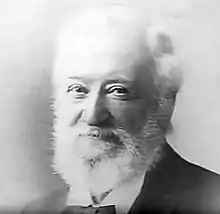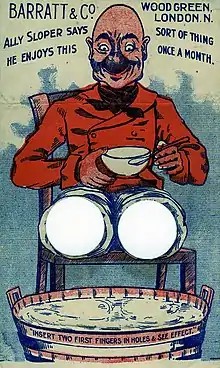George Osborne Barratt
George Osborne Barratt (1827-1906) was a confectioner who, at age 21, set up what was to become Barratt & Co., Ltd., using premises at 32 Shepherdess Walk, Hoxton. Several of his siblings and children became involved in the business, aiding its growth and development. By the time of Barratt’s death the firm had become the largest confectionery manufacturer in the world. The company was taken over by Bassett's in 1966, then by Cadbury Schweppes in 1989 and, since 2008, has been part of the Tangerine Confectionery portfolio. The Barratt brand name was brought back in 2018.
George Osborne Barratt | |
|---|---|
 George Osborne Barratt, founder of Barratt & Co. Ltd., Confectioners | |
| Born | 1827 |
| Died | October 3, 1906 (aged 78–79) Crouch Hill, Middlesex |
| Nationality | British |
| Occupation | Confectioner |
| Spouse(s) | Sarah Peterson |
Family Life

George Osborne Barratt (1827-3 October 1906) was the tenth of fifteen children of William Barratt and Caroline Jane Harriskine. The Barratts were law bookbinders at 21 Portugal Street, near Lincoln’s Inn.[1] George married Sarah Peterson on 18 February 1849, at St Clement Danes, Westminster.[2] They had six girls and five boys, all born in Hoxton. The couple celebrated their golden wedding over three days in February 1899, beginning with “an excellently-prepared banquet […] to which ample justice was done”, provided by Messrs. Spiers and Pond, well known for their catering establishments.[3] On the second day some 200 male employees were entertained at a banquet in the company’s main show room; followed, next day, by a similar celebration with 250 female staff.[4] After many years of illness and several operations Barratt died from jaundice at his home at Holly Mount, Crouch Hill, Middlesex on 3 October 1906, leaving an estate worth nearly £154,000.[5] He was buried at Highgate Cemetery on 5 October, alongside his wife, who was interred on 7 September 1905.
Barratt was known to be a very hard worker and passionate about his endeavour. He acknowledged, though, that he was not a practical confectioner. He couldn't make sweets but he could "think" them. The press called Mr G. O. Barratt "King of Confectioners".[6]
Business Life
George did not follow the family trade. After leaving school he entered a lawyer’s office where he remained for some years.[6] After his marriage he went into short-lived business as a pastry cook with his brother James. He then started a sugar confectionery business employing one sugar boiler at 32 Shepherdess Walk, Hoxton. The enterprise was successful: it grew rapidly and neighbouring properties were bought up to allow for the expansion. Barratt himself travelled, in his pony and trap, to deliver and promote his products in and around London. Then, his eldest son George (1852-1928), when he was about 17, took over these journeys, and Barratt senior worked large parts of the country for the next 20 years. Part of the company’s success was attributable to a product sold as 'stickjaw' toffee – said to have been made accidentally – that was very popular with children.[7]
When the company outgrew its Hoxton site it moved to a former piano factory, owned by a Mr Ivory, in Mayes Road, Wood Green, north of London. The first building was ready in 1882.[8] By 1904 eight buildings were in use on nearly 5 acres, despite the setback of a serious fire on 18 October 1899 in which five buildings were destroyed.[9] Two years later there were around 2,000 employees producing 350 tonnes of sweets a week, making Barratts the largest confectionery manufacturer in the world.[10]
George Osborne Barratt died in 1906. In 1909, under the chairmanship of his eldest son George William (1851-1928), the firm became a limited company, valued at £330,000.[11] George Osborne’s youngest son Albert (1860-1941) was chairman and managing director from 1911 to 1921. He was knighted in 1922 for public services. Sir Albert died on 28 November 1941 at his home (Totteridge Park, Hertfordshire) and is buried in the family grave at Highgate Cemetery.
Barratt & Co. Ltd. was acquired in a friendly takeover by Bassett's in 1966,[12] which in turn was taken over by Cadbury Schweppes in 1989. Since 2008 it has been part of the Tangerine Confectionery portfolio. The Barratt brand was brought back into use in 2018.[13] After a long decline, the company closed its Wood Green site in 1980. Bounded by Coburg Road, Mayes Road and Western Road, the site has since been occupied by The Chocolate Factory.[14]
A selection of old photographs, brochures and letters from former employees is held in the archives of the London Borough of Haringey at Bruce Castle Museum.
Product Lines
In the early days the product range was mainly “boilings” such as butter, raspberry and ginger toffees. Later it included Almond Rock, Brandy Snaps, Stickjaw, Coffee Almonds, Brandy Nips, Ching Chang Marbles and Coker Tines. Later came Tichborne Rock, a pulled rock in which the figure of Sir Roger Tichborne was incorporated. It was displayed in shop windows with a card saying “Crack the rock where’re you will / You’ll find Sir Roger in it still”. It was said to have been the most talked-about line of confectionery Mr Barratt ever invented.[6]

In the 1880s came Yankee Panky (a low-boiled sweet wrapped in wax paper – an industry first), Rose Pastilles and Refresher Sticks. Black Jack and Fruit Salad appeared in 1920, followed by the famous Sherbet Fountain in 1925. The sherbet was contained in a paper-wrapped cardboard tube with a liquorice “straw” stuck in the top. By the 1950s Barratt’s produced some 200 lines of confectionery, mainly from seven types of manufacture: Rock, Sweet Cigarettes, Sherbet Products, Starch Goods, Liquorice, Boilings and Caramels & Toffees.[15]
Tangerine Confectionery’s newly reintroduced Barratt brand portfolio includes DipDab, Refreshers, Nougat, Sherbet Fountain, Fruit Salad, Black Jack, Wham, Refreshers Softies and Fruit Salad Softies.[13] The modern version of the Sherbet Fountain, introduced in 2009, was not to everyone’s satisfaction.[16]
Staff Relations
Although there was a week-long strike in September 1890, it involved only about a third of the 600 staff, and was prompted by the Gas Stokers’ union.[17] Generally management-staff relationships were good, and the company’s own union was established in the early 1890s as “Barratt & Co.’s and Employees Aid & Protective Union.” Rule 6 stated that membership of any other Trade or Business Union was not permitted. Employees contributed from 1d. to 3d. per week, depending on their wages (from under 12/- to over 18/- ), and received benefits on production of a certificate signed by a doctor.
On several occasions staff expressed their appreciation of the management, e.g. on the occasion of the golden wedding of George and Mrs Barratt in 1899, and in gratitude for an outing to Southend in 1910.
A social club was opened in the 1930s, providing a club room, snooker, darts, dancing and a drama section.[15] The company also provided a surgery with a full-time nurse and visiting doctor. The factory had a chiropodist and a fully equipped dental centre, with a dentist calling once a week.
References
- Cowie, George (1833). The Bookbinder's Manual : containing a full description of leather and vellum binding, etc (Fifth ed.). London: William Strange. p. 116.
- "England, Select Marriages, 1538–1973". Ancestry. Retrieved 10 March 2020.
- Assael, Brenda (2018). The London Restaurant, 1840-1914. Oxford: Oxford University Press. pp. 31–33. ISBN 978-0-19-881760-4.
- "Mr and Mrs G. O. Barratt's Golden Wedding", The Middlesex Gazette, 4 March 1899
- "England & Wales, National Probate Calendar (Index of Wills and Administrations)". Ancestry.co.uk. Retrieved 10 March 2020.
- Saunders, W. Clarke (October 1906), "The Late Mr. George O. Barratt; an Appreciation", Confectioners' Union, London
- "Our Story". Barratts Sweets. Tangerine Confectionery. Retrieved 26 January 2020.
- Plowright, Dennis G. "Barratt & Co., Ltd., Manufacturing Confectioners, Wood Green". GLIAS. Greater London Industrial Archaeology Society. Retrieved 10 March 2020.
- "Fire at Wood Green", Lloyd's Weekly Newspaper, p. 18, 22 October 1899
- "The Fizzy History of Barratt & Co". Let's Look Again. 4 September 2015. Retrieved 31 January 2020.
- "Barratt & Co., Ltd.", The Times, London, p. 17, 14 January 1909
- "Bassett offers £3.9M. for Barratt", The Financial Times, London, p. 14, 29 September 1966
- "Barratt brand back in business". Tangerine. Tangerine Confectionery. 31 January 2018. Retrieved 31 January 2020.
- "The history of The Chocolate Factory in Wood Green". Welcome to Workspace. Workspace Group PLC, London. Retrieved 6 February 2020.
- Plowright, Dennis G. (2004). "Barratt & Co., Ltd., Manufacturing Confectioners, Wood Green". Greater London Industrial Archaeology Society. Retrieved 2 February 2020.
- Goldstein, Simeon (28 April 2009). "Media outcry as Sherbet Fountain drops paper for plastic". Packaging News. Retrieved 15 February 2020.
- "The Strike at Wood Green", Lloyd's Weekly Newspaper, p. 9, 14 September 1890